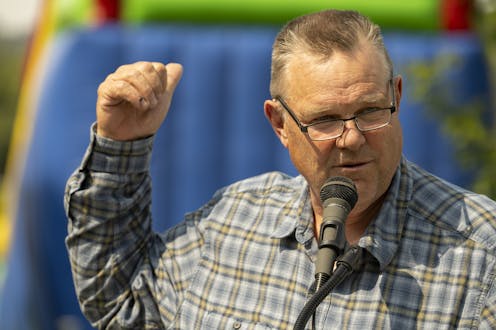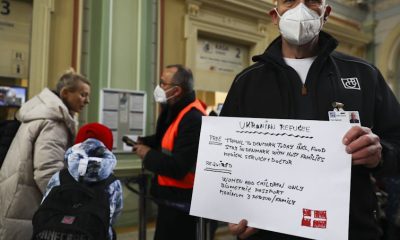
U.S. Sen. Jon Tester speaks to union members at a Labor Day campaign stop on Sept. 2, 2024, in Billings, Mont. William Campbell/Getty Images
Jon Tester has never had it easy.
The three-term Democratic senator from Montana has scored more than 50% of the vote only once in his three runs for the U.S. Senate, attracting 50.3% of the vote in 2018 against state auditor and future U.S. Rep. Matt Rosendale.
This year, Tester’s always-perilous path to reelection seems narrower and more harrowing than ever before. And the outcome could determine whether the Senate remains in Democratic control or flips to the Republicans.
Current polls and political prognosticators are even starting to turn on the moderate from the farming community of Big Sandy with the flattop haircut. FiveThirtyEight has Tester’s opponent, former Navy SEAL and businessman Tim Sheehy, up four percentage points, and the venerable Cook Political Report has gone so far as to say the race “leans Republican.”
For Montana State University political scientist Jessi Bennion, this election may be the end of an era in rural America.
“I used to always call Tester the unicorn candidate because there was no one like him,” she told my students a couple of weeks back. “He was a farmer, he was a rural Democrat, the last rural Democrat.”
Jon Tester, right, first won election to the U.S. Senate in 2006, when he beat Republican incumbent Conrad Burns, left, by a margin of 3,562 votes out of 406,505 cast.
Win McNamee/Getty Images
The end of the unicorn?
I teach political reporting at the University of Montana School of Journalism, and every two years I send students out to interview candidates, profile races and talk with voters. It is true that the state has changed even since Tester won in 2018.
Despite an influx of outsiders over the past decade, Montana is still a sparsely populated state boasting 1.1 million people in the latest census. Though the state has historically relied on mining and timber for much of its economy, new economic activity in tourism and technology have helped fuel a 10% jump in population in the most recent census.
But with that influx, housing costs have soared and so have property taxes. It also leaves one of Montana’s political traditions in danger.
See, Montana has a history of doing something very few people do these days – ticket splitting, when a person votes in an election for candidates from opposing parties. In a time of deep polarization, it is hard to imagine, but out here in the Rocky Mountains and the northern plains, voters would consistently vote for a Republican for president and often for the Legislature, but also for Democrat Jon Tester.
Tester was able to put together a coalition of voters in the few pockets of liberals – college towns such as Missoula, union strongholds such as Butte and Indigenous voters on the reservation – and carve away enough moderate voters in more rural areas to eke out wins. When I moved here in 2009, it was not just Tester who did this. Back then, Montana had a Democratic governor, attorney general and head of schools. But over time those statewide offices have all gone, often by double digits, to Republicans.
No Democrat has won statewide since Tester did it back in 2018.
Migration and the march from purple to red
Then COVID-19 hit Montana.
The state saw a surge in population, jumping nearly 5% between 2020 and 2023, and experts such as political scientist Jeremy Johnson told my students earlier this fall that it is important to know who these new residents are.
“I still think the race, you know, can be competitive,” Johnson said. “I do think that some of my broader themes here – the polarization, the calcification, the reluctance to ticket split – makes it harder for Tester. Plus, I think there is some evidence that more Republican-leaning voters have moved to the state than Democrat-leaning voters in the last few years.”
One analysis reported on by the Montana Free Press found that for every two Democrats who moved to Montana since 2008, three Republicans did.
Montana does not have party registration, so when you vote in a primary, they give you a ballot for both parties, and you choose the one you want to participate in. In the highly publicized U.S. Senate primary this year, only 36% of primary voters voted in the Democratic primary, while 64% chose to vote in the Republican primary.
The one question mark of 2024
Supporters of an abortion rights initiative at a rally on Sept. 5, 2024, in Bozeman, Mont., with Sen. Jon Tester, whose path to reelection may be helped by a large turnout of abortion rights voters.
William Campbell/Getty Images
Ask Sen. Tester, and he will say his campaign is anything but over. He is stressing his independence from his political party, how Republican President Donald Trump signed bills he sponsored and his long-running support of veterans as cornerstones of his campaign.
But his path to reelection may run right through Roe v. Wade.
Montana’s constitution was written in 1972, and it has some pretty progressive elements, including a right to a clean environment and an explicit right to privacy, as opposed to the more implied one in the U.S. Constitution. And in 1999, the state Supreme Court said that right to privacy included abortion access.
Still, in part to ensure that a later court decision could not strip away that right, voters have put CI-128 on the ballot this fall, which would explicitly include protection for abortion access in the state constitution.
Tester hit the issue hard in his last debate with Sheehy on Sept. 30, 2024.
“The bottom line is this: Whose decision is it to be made?” Tester said during the debate. “Is it the federal government’s decision, the state government’s decision, Tim Sheehy’s decision, Jon Tester’s decision? No, it’s the woman’s decision. Tim Sheehy’s called abortion ‘terrible’ and ‘murder.’ That doesn’t sound to me like he’s supporting the woman to make that decision.”
Tester’s supporters hope the initiative could inspire younger voters and moderate women to flock to the polls this fall, and that might make Tester’s path to reelection a bit more doable.
But it is going to take a bit of unicorn magic, perhaps, for Tester to win a fourth term.
Back at Montana State University, Bennion said the situation looks pretty dire for the Democrats in rural states.
“I don’t see, unless our state changes in a lot of different ways, I don’t see a Democrat winning in a long time,” he said. “Just the way our state is growing, the kind of person that is moving here and voting.”
Lee Banville does not work for, consult, own shares in or receive funding from any company or organization that would benefit from this article, and has disclosed no relevant affiliations beyond their academic appointment.
Advertisement

Advertisement
Contact Us
If you would like to place dofollow backlinks in our website or paid content reach out to info@qhubonews.com











